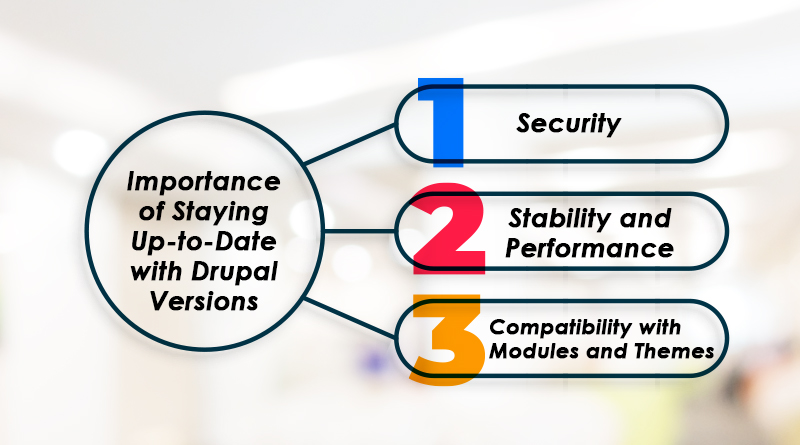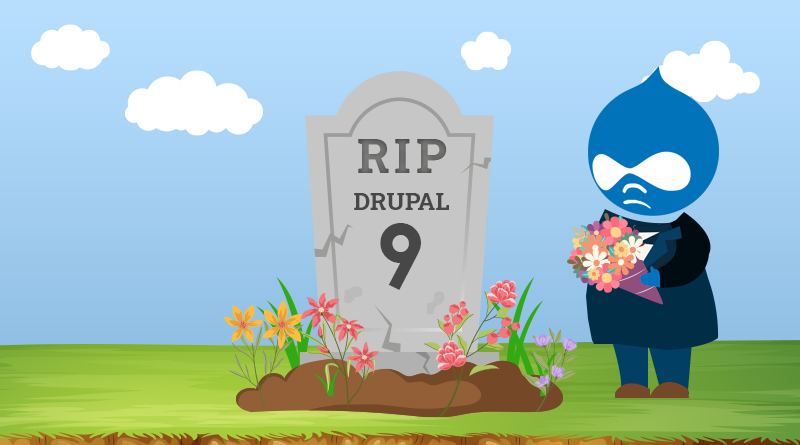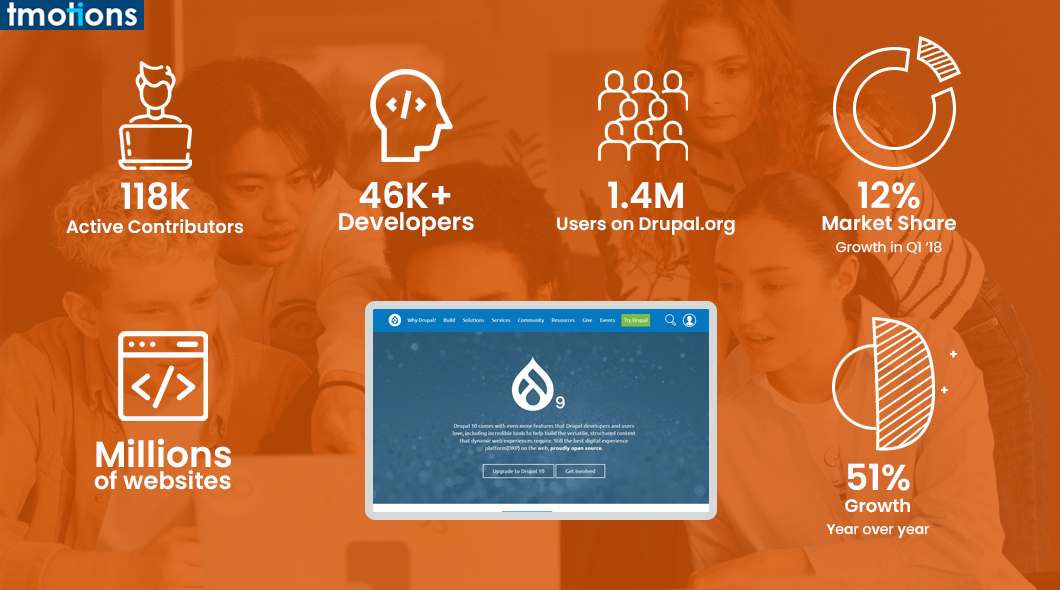Drupal 9 End-of-Life (EOL)
As technology continues to evolve at a rapid pace, software products reach a stage where they require updates, improvements, and eventually, a transition to a new version. Drupal 9, the powerful content management system (CMS) that has been empowering websites worldwide, has reached its End-of-Life (EOL) phase. EOL signifies the end of official support and updates for Drupal 9 by the Drupal community.
Workforce Management for Construction Enterprises | Maximizing GA4 | Power of Accessibility Testing
Drupal 9 End-of-Life as an Opportunity for Growth
While the term “End-of-Life” might sound daunting, it’s crucial to approach this phase with a positive perspective. Drupal 9 EOL represents a new beginning rather than the end. It’s an opportunity for growth, innovation, and embracing the next evolution of Drupal. This transition opens doors to enhanced features, improved performance, and increased security, ensuring that Drupal remains at the forefront of web development.
Drupal’s EOL phase symbolizes the community’s commitment to pushing the boundaries and constantly improving the platform. It serves as a reminder that technology is ever-evolving, and by adapting to change, we pave the way for a more robust and sustainable digital future.
In the upcoming sections of this blog, we will delve deeper into the Drupal 9 EOL phase, understand its implications, and explore the opportunities it presents. So, let’s embark on this journey together and discover why Drupal 9 EOL is not the end, but rather a new beginning for website owners, developers, and the entire Drupal community.
Drupal Commerce vs Magento | Drupal 9 Features | NopCommerce | Microsoft Dynamics 365 and nopCommerce
Reasons Behind Drupal 9 Reaching EOL
Drupal 9, being a dynamic CMS, has reached its EOL for specific reasons that highlight the continuous progress and innovation within the Drupal ecosystem. Some of the key factors contributing to Drupal 9 reaching EOL include:
-
Technological Advancements
As technology evolves, newer frameworks, libraries, and coding practices emerge. Drupal 9 EOL allows the Drupal community to align with these advancements and take advantage of improved performance, scalability, and security.

-
Seamless Upgrades
Drupal 9 was designed to provide a smooth upgrade path from Drupal 8. By reaching EOL, the community can focus on ensuring a seamless transition to the next major version, Drupal 10, offering enhanced features and functionality.
-
Streamlined Maintenance
By moving forward with Drupal 10, the community can streamline maintenance efforts and allocate resources more effectively. This enables faster development cycles, quicker bug fixes, and improved support for the Drupal ecosystem as a whole.
Debunking Misconceptions about Drupal 9 End-of-Life
The Drupal 9 End-of-Life (EOL) phase may raise concerns and misconceptions among website owners and developers. It’s important to address these to provide a clear understanding of the situation. Some common concerns and misconceptions include:
-
Security Risks
One misconception is that Drupal 9 EOL automatically means websites will become insecure. However, the Drupal community is committed to addressing security vulnerabilities during the EOL phase through contributed modules and ongoing support until the recommended upgrade path is followed.
-
Forced Migration
Website owners may worry that they are being forced to migrate immediately. In reality, Drupal 9 will still function after EOL, but it won’t receive official updates or support. The transition to Drupal 10 can be planned strategically based on the website’s needs and priorities.
NopCommerce vs Magento | Digital Transformation | Microsoft Dynamics 365 For Sales
Potential Challenges and Risks for Drupal 9 Website Owners
Website owners who choose to remain on Drupal 9 beyond its EOL phase may face certain challenges and risks. These include:
-
Limited Support
With the end of official support, the availability of community support, bug fixes, and security patches will decrease over time. This could leave websites more vulnerable to potential security threats.
-
Compatibility Issues
As the web ecosystem evolves, third-party modules and integrations may start to rely on Drupal 10 features, potentially causing compatibility issues with Drupal 9. This can impact the website’s functionality and limit its ability to leverage new technologies.
-
Missed Enhancements
Staying on Drupal 9 means missing out on the enhancements, performance improvements, and new features introduced in Drupal 10. This could hinder the website’s ability to stay competitive and deliver the best user experience.
Website owners on Drupal 9 must assess the potential challenges and risks they may face and make an informed decision about their migration strategy. Understanding these factors can help them plan for a smoother transition and mitigate any negative impact on their websites.
Migrating to Drupal 10: Unlocking Advantages and Opportunities
The transition from Drupal 9 to its successor, Drupal 10, presents numerous advantages and opportunities for website owners. Exploring the benefits of migration includes:
-
Enhanced Performance
Drupal 10 introduces optimizations and refinements that result in improved website performance, faster page load times, and a smoother user experience.
-
Security and Stability
With Drupal 10, website owners can leverage the latest security enhancements and patches, ensuring their websites are better protected against emerging threats.
-
Long-Term Support
By migrating to Drupal 10, website owners gain access to long-term support and updates from the Drupal community, providing ongoing maintenance, bug fixes, and security patches.
Power Up your B2B eCommerce with Search | How Food Went High Tech | Immersive eCommerce is Here
New Features and Improvements in Drupal 10
Drupal 10 brings exciting new features and improvements that enhance the overall website-building experience. Highlights of Drupal 10 include:
-
Modernized Technology Stack
Drupal 10 embraces the latest versions of underlying technologies, such as PHP and Symfony, ensuring compatibility with the evolving web landscape.
-
Improved Editor Experience
Drupal 10 introduces enhancements to the content editing workflow, making it more intuitive, user-friendly, and efficient for content creators and editors.
-
Accessibility Enhancements
Accessibility is a core focus in Drupal 10, with improved support for web accessibility standards, ensuring inclusive digital experiences for all users.
Migration Process from Drupal 9 to Drupal 10
Migrating from Drupal 9 to Drupal 10 requires careful planning and execution. Here is a high-level overview of the migration process:
-
Evaluate Compatibility
Assess the compatibility of your Drupal 9 site with Drupal 10 by reviewing contributed modules, custom code, and themes to ensure they are compatible or have alternative solutions available.
-
Update Contributed Modules
Ensure that all contributed modules used in your Drupal 9 site have Drupal 10-compatible versions. If not, explore alternative modules or consider contributing to the community by helping update the modules.
-
Review Custom Code and Themes
Examine any custom code or themes in your Drupal 9 site to identify necessary updates or modifications required for Drupal 10 compatibility.
-
Plan and Test
Develop a migration plan that includes thorough testing of the migration process in a controlled environment. This allows you to identify and address any issues or conflicts before performing the actual migration.
-
Execute the Migration
Follow the established migration plan to migrate your Drupal 9 site to Drupal 10. This involves exporting and importing data, updating configurations, and ensuring the successful migration of content and functionality.
Ultimate Guide To ChatGPT | Workforce Management for Construction Enterprises
Importance of Staying Up-to-Date with Drupal Versions

Staying up-to-date with Drupal versions is essential for the long-term success and continued growth of your website. Here’s why:
-
Security
Drupal releases updates and security patches regularly to address vulnerabilities and protect websites from potential threats. By staying on the latest Drupal version, you ensure that your website benefits from the most recent security enhancements, keeping it secure and safeguarding your users’ data.
-
Stability and Performance
Each new Drupal version introduces improvements in performance, stability, and overall functionality. Upgrading to the latest version allows you to leverage these enhancements, resulting in a better user experience and optimized website performance.
-
Compatibility with Modules and Themes
As the Drupal ecosystem evolves, module and theme developers prioritize compatibility with the latest Drupal versions. By staying up-to-date, you ensure compatibility with the latest versions of contributed modules and themes, allowing you to take advantage of new features and functionality.
Conclusion
In conclusion, we encourage readers to embrace the transition from Drupal 9 to Drupal 10 and look forward to a new beginning. We invite website owners and developers to plan their migration strategy, stay informed about the latest updates and resources, and actively engage with the Drupal community. By doing so, they can navigate the migration process smoothly and set their websites up for long-term success.
Remember, Drupal 9 EOL is not the end of the world. It’s a transformative phase that paves the way for innovation, improved functionality, and continued growth. Embrace the transition, seize the opportunities that lie ahead, and embark on a journey of continuous improvement with Drupal 10. Together, let’s shape a brighter future for your Drupal-powered websites.
We hope that this blog has helped clarify any doubts you may have had about navigating the Drupal 9 End-of-Life phase. If you still have any questions or concerns regarding Drupal 9 EOL and the transition to Drupal 10, please don’t hesitate to reach out to our expert team.
Leveraging the Metaverse for Business Success | 5 Trends Shaping Grocery Retail | Winning at B2B Commerce














